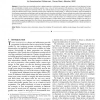Free Online Productivity Tools
i2Speak
i2Symbol
i2OCR
iTex2Img
iWeb2Print
iWeb2Shot
i2Type
iPdf2Split
iPdf2Merge
i2Bopomofo
i2Arabic
i2Style
i2Image
i2PDF
iLatex2Rtf
Sci2ools
PAMI
2011
2011
3D Face Reconstruction from a Single Image Using a Single Reference Face Shape
—Human faces are remarkably similar in global properties, including size, aspect ratio, and location of main features, but can vary considerably in details across individuals, gender, race, or due to facial expression. We propose a novel method for 3D shape recovery of faces that exploits the similarity of faces. Our method obtains as input a single image and uses a mere single 3D reference model of a different person’s face. Classical reconstruction methods from single images, i.e. shape-from-shading, require knowledge of the reflectance properties and lighting as well as depth values for boundary conditions. Recent methods circumvent these requirements by representing input faces as combinations (of hundreds) of stored 3D models. We propose instead to use the input image as a guide to ”mold” a single reference model to reach a reconstruction of the sought 3D shape. Our method assumes Lambertian reflectance and uses harmonic representations of lighting. It has been tested on i...
| Added | 14 May 2011 |
| Updated | 14 May 2011 |
| Type | Journal |
| Year | 2011 |
| Where | PAMI |
| Authors | Ira Kemelmacher-Shlizerman, Ronen Basri |
Comments (0)

